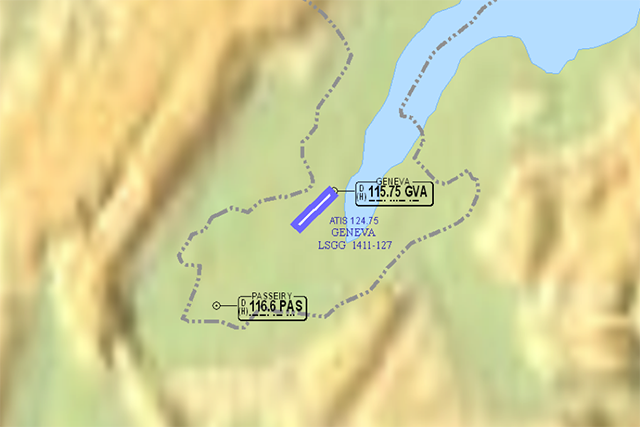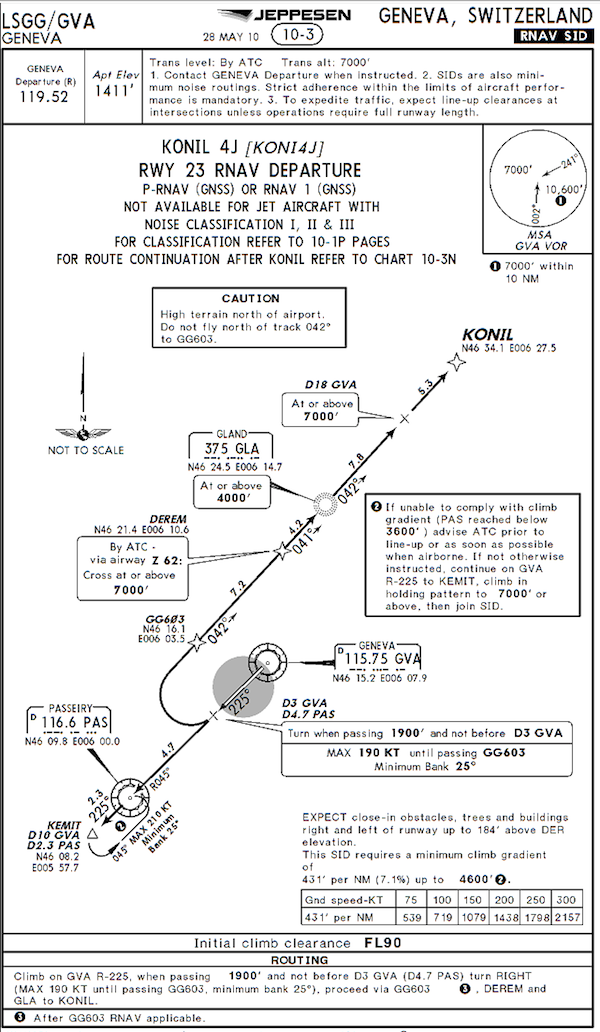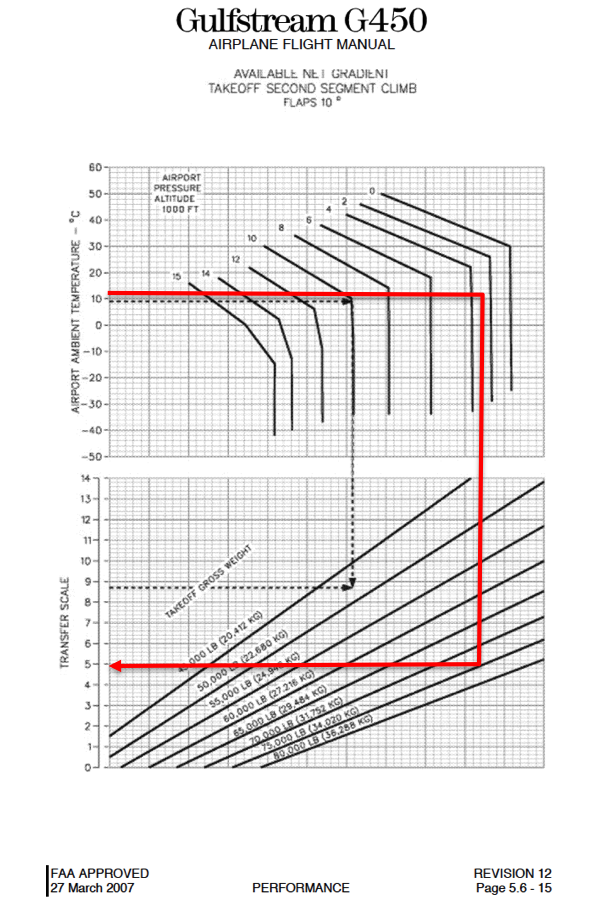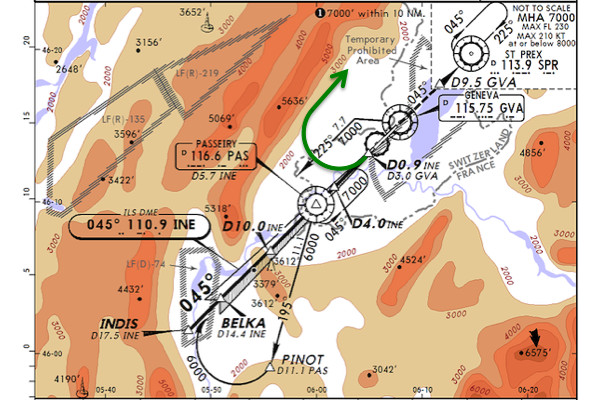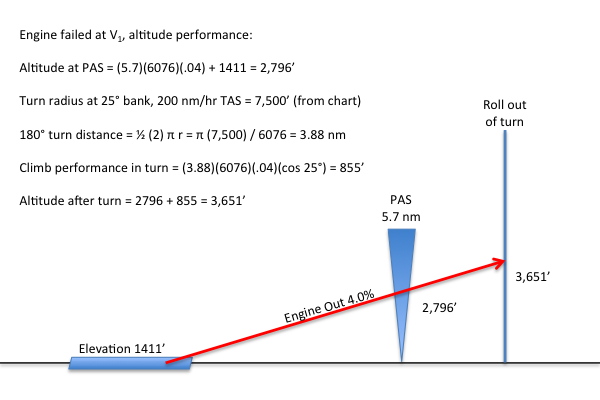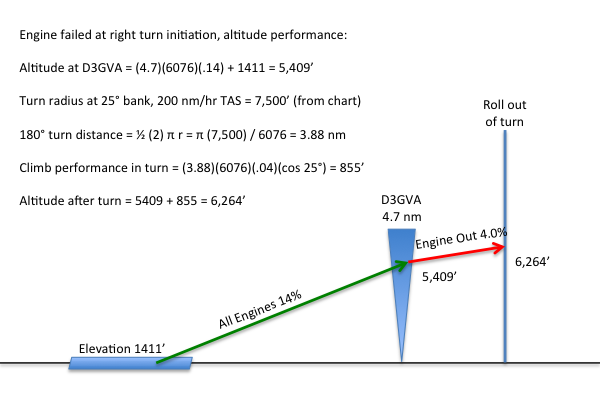Airport departure procedures sometimes cross obstacles when there are other options simply because the direction of travel or other considerations take precedence. In cases like these the obstacle climb gradients can impose weight penalties that make takeoff unfeasible unless pilots come up with alternate procedures in the event of an engine failure.
— James Albright

Updated:
2014-10-22
You can do all of this with obstacle analysis software, as covered in Departure Obstacle Avoidance. But even armed only with what you will find in your JeppView EFB, you can do better than the SID and AFM method. The Latin term "Ad Hoc" means "for this" and using an ad hoc obstacle analysis allows you to examine a specific situation and come up with a safe game plan for beating specific obstacles.
What follows is an example using the airport in Geneva, Switzerland (LSGG) flying a G450 on an ISA day, with quotes from relevant regulatory documents, listed below and my comments and techniques. (Note: I've had the same issues at LSGG in aircraft that climb better, the GV, and worse, the CL604. The technique works for a variety of aircraft.)
Note: I do not recommend you do this if you don't have a good understanding of your aircraft's engine out performance or do not have anything better than what I would call "average pilot math skills." Some would advise you to rely on airport analysis software, as covered in Departure Obstacle Avoidance. But I would also argue that if you don't understand the concepts behind doing this manually, you shouldn't be using the software either.

1
Standard Instrument Departure (SID) constraints
A typical departure from LSGG requires a 7.1% climb gradient to 4,600 feet with a right turn over a mountain range just 5 nm to the west.
Standard Instrument Departures (SID) or Departure Procedures (DP) based on TERPS or ICAO Procedures for Air Navigation Services—Aircraft Operations (PANS-OPS) are based on normal (all engines operating) operations. Thus, one-engine-inoperative obstacle clearance requirements and the all-engines-operating TERPS requirements are independent, and one-engine-inoperative procedures do not need to meet TERPS requirements. Further, compliance with TERPS all-engines-operating climb gradient requirements does not necessarily assure that one-engine-inoperative obstacle clearance requirements are met. TERPS typically use specified all-engines-operating climb gradients to an altitude, rather than certificated one-engine-inoperative airplane performance. TERPS typically assume a climb gradient of 200 feet per nautical mile (NM) unless a greater gradient is specified. For the purposes of analyzing performance on procedures developed under TERPS or PANS-OPS, it is understood that any gradient requirement, specified or unspecified, will be treated as a plane which must not be penetrated from above until reaching the stated height, rather than as a gradient which must be exceeded at all points in the path. Operators must comply with 14 CFR requirements for the development of takeoff performance data and procedures. There are differences between TERPS and one-engine-inoperative criteria, including the lateral and vertical obstacle clearance requirements. An engine failure during takeoff is a non-normal condition, and therefore takes precedence over noise abatement, air traffic, SIDs, DPs, and other normal operating considerations.
Source: AC 120-91, ¶7.a.
With all engines operating, you are expected to make the 7.1% climb gradient. Pilots flying aircraft with all-engine climb gradient charts (like the GV) have no problems verifying this capability. Other pilots often use their engine-out charts reasoning that if they can do it with an engine out, they can do it with all engines operating. But there is often a better way. G450 pilots, for example, can use their Aircraft Operating Manual en route climb charts.
Using the operating manual's en route chart, we see the G450 can climb to 5,000 feet in 6 nm for a climb rate of 5000 / 6 = 833 ft/nm at maximum takeoff weight on both engines. That equates to a (833 / 6076) = 14% climb gradient.
We see that we can beat the SID climb gradient on two engines even if we fuel the aircraft for maximum takeoff gross weight. What about with an engine out?
2
Engine out performance
The G450 AFM has charts for engine out climb performance in section 5.6. Using 12°C for our ISA day at 1,411' elevation, the first page gives us a transfer number of 5.0
Bringing the transfer number down through the required climb height results in a gradient of 4.0%.
It appears we cannot meet the SID requirements engine-out at maximum gross weight. We could chase the charts backwards, entering with the required 7.1% gradient, and make the requirements if we reduce our gross weight to 62,000 lbs. So, using conventional techniques, we would leave behind 12,000 lbs of fuel and reduce our range by several hours.
3
Situational awareness
The SID does not depict terrain and simply tells you to commence your right turn "when passing 1900' and not before D3 GVA."
If you lose an engine, no matter when you begin your right turn, you will be facing terrain above you. Your turn diameter will be around 4 nm which places you over the mountains to the west. Flying this SID at maximum gross weight with an engine failed will not work.
Amazingly, a better DEPARTURE idea presents itself on this APPROACH chart.
4
Ad hoc obstacle avoidance
Ad Hoc Plan of Attack
There is much more terrain-free airspace to the east than the west, so why not use it if you lose an engine? But it is important to have a clearly understood game plan so that no matter when an engine is lost, there is no confusion. An easy plan of attack would be to say if an engine failure happens prior to the right turn, we press on to the the Passeiry VOR then turn left direct the Geneva VOR and hold. If the engine failure happens after we start the right turn, we continue the right turn knowing our altitude at that point will keep us safe. But will it? We need to investigate our vertical performance for either case before committing to this Ad Hoc game plan.
Ad Hoc Performance, Engine Fails Before Right Turn
LSGG Vertical Performance, Engine Fails Prior to Right Turn.
Using some basic math and turn performance charts (available here: Turn Performance.) we see losing an engine prior to the right turn gives us ample terrain clearance overhead Passeiry and at the completion of our turn north.
The plan works in the event of an engine failure after V1 and prior to the right turn.
Ad Hoc Performance, Engine Fails After Right Turn
LSGG Vertical Performance, Engine Fails Prior to Right Turn.
If the engine failure occurs right at the moment the right turn is initiated, the aircraft's 14% twin-engine climb gradient to that point almost has the mountain range beat. The less robust climb in the turn with an engine failed makes up the difference and you will be well above the obstacle before completing the turn.
The plan also works in the event of an engine failure after initiating the right turn.
The LSGG Ad Hoc Game Plan
I would (and have several times):
- Load the airplane to maximum gross weight, if needed for the trip and provided the climb performance checks for both engine loss scenarios (before and after initiating the right turn), as well as required SID performance with all engines operating.
- Brief the crew: "In the event of an engine failure prior to initiating the right turn, we will proceed straight to the Passeiry VOR, then left turn to the Geneva VOR and enter hold. If we lose the engine after initiating the right turn, we will continue the SID as published."
- If an engine fails, declare an emergency and tell ATC what you are going to do.
- If an engine doesn't fail, press on to your destination, made possible by the increased payload of your Ad Hoc approach to obstacle clearance.
References
(Source material)
Advisory Circular 120-91, Airport Obstacle Analysis, 5/5/06, U.S. Department of Transportation
Gulfstream G450 Aircraft Operating Manual, Revision 35, April 30, 2013.
Gulfstream G450 Airplane Flight Manual, Revision 35, April 18, 2013
Please note: I've used some Gulfstream performance charts for the purposes of education. Gulfstream Aerospace Corporation has no affiliation or connection whatsoever with this website, and Gulfstream does not review, endorse, or approve any of the content included on the site. As a result, Gulfstream is not responsible or liable for your use of any materials or information obtained from this site.
